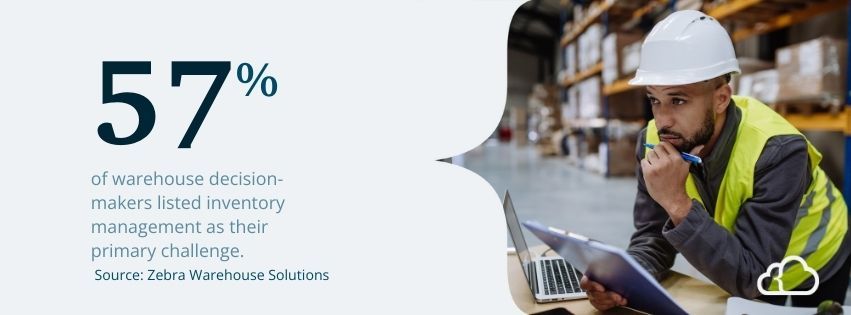5 Ways to Breeze Through Warehouse Distribution Challenges
A properly run warehouse requires meticulous inventory tracking and near-perfect labor management. The right software provides the tools your company needs to make that possible.
Those obstacles are only getting more difficult as online shopping gains popularity. A 2022 Peerless Research Group study reported that 57% of surveyed employees of the warehouse and manufacturing industries felt e-commerce was boosting manufacturing distribution, a 10% increase from the previous year. They also said the majority (55%) of packaging and fulfillment for that distribution happened in warehouses.
Consequently, warehouse distribution operations are becoming more critical as demand rises for at-home deliveries. Managers must ensure growing amounts of inventory are received, cataloged, picked, packed, and shipped precisely. However, skyrocketing inventory and high customer expectations can make this job feel impossible.
NetSuite’s Warehouse Management System offers various tools, such as real-time inventory management, automated workflows, and supply chain control towers, to keep operations humming smoothly.
SuiteDynamics works with NetSuite to customize and implement NetSuite Enterprise Resource Planning (ERP) systems. Our experts can help your company evaluate its warehouse distribution needs and determine the right NetSuite solutions to solve them.
Read our guide below to discover five common inventory challenges the system can solve. Then, schedule a free consultation with our team. We’ll provide the software to ensure your warehouse is properly stocked, your products are shipped on time, and your customers stay happy.

1. Inventory Management Woes
In 2019, 57% of warehouse decision-makers listed inventory management as their primary challenge for the subsequent five years, according to Zebra Warehouse Solutions.
It’s easy to see why; warehouse managers face a host of challenges. They must track thousands of SKUs, manage stock levels, and prevent overstock and stock-outs. It’s a logistical nightmare.
Unfortunately, too many of these managers oversee their inventory with manual processes, which puts the business at risk for costly errors that complicate warehouse distribution. It’s not hard for a harried employee to key in an incorrect SKU and create a web of issues that snarls operations for days.
NetSuite’s Solution:
A NetSuite ERP system provides users with real-time inventory management. It offers a bird’s-eye view of stock levels across multiple locations to monitor inventory levels as they rise and fall. Automated reorder points also ensure you’re never surprised by sudden demand spikes.
The system also allows you to track items from dock to shelf upon receipt. You always know where products are, whether new or returned stock. Additionally, NetSuite includes inbound putaway strategies that recommend bins for each item based on inventory attributes, thus increasing warehouse efficiency and accuracy.
Consequently, you can say goodbye to manual inventory counts that take days and hello to accuracy and speed throughout your warehouse distribution process.
Key Inventory Management Features:
- Automated Inventory Tracking
- Multi-Location Fulfillment
- Demand-Based Replenishment
- Automated Inventory Counts
- Lot and Serial Tracing
- Full Item Visibility
SuiteDynamics experts can explain NetSuite inventory management capabilities more during your free consultation. We can even demo the system upon request.
2. Order Fulfillment Headaches
Efficient order fulfillment is critical. Delays and inaccuracies can lead to unhappy customers and lost business. Therefore, warehouse managers must juggle order picking, packing, and shipping across different channels.
Additionally, customer expectations are rising. E-commerce companies like Amazon have accustomed people to fast shipping, so other retailers feel pressured to provide the same. Jim Gehr, DHL Supply Chain’s president of retail North America, told Supply Chain Dive that these expectations demand an increase in warehouse distribution efficiency.
“Historically, warehouses would receive an order, and they ship it out 48 hours later,” he said. “Today, warehouses receive an order and it’s ready to ship in two hours. That’s a very complex process.”
Therefore, warehouse managers must have an infallible system for coordinating each shipping element or the entire company will fall behind the times.
NetSuite’s Solution: NetSuite uses automated workflows to streamline the order fulfillment process. Everything is synced and tracked from order capture to shipping in one system. This method offers faster, more accurate order processing and happier customers.
Plus, with real-time updates, you can keep your customers in the loop about their order status.
Key Order Fulfillment Features:
- Mobile Apps with Predefined Picking Strategies
- Cross-Subsidiary Fulfillment
- Carrier Integration
If you have questions about NetSuite’s order fulfillment capabilities, schedule a free consultation with our team. We’ll ensure you understand the system’s benefits and can even suggest the best features to suit your company’s needs.

3. Lack of Supply Chain Visibility
A lack of visibility into the supply chain can result in delayed shipments, missed opportunities, and reactive (rather than proactive) decision-making.
You can’t adequately manage warehouse distribution if you don’t know when the next shipment is coming or what’s in it. Your team will end up sitting around waiting for new tasks or scrambling at the last minute when a truck shows up, creating chaos.
Visibility issues also mess with inventory management. You run out of some items and overstock others, preventing order fulfillment and tying up entirely too much capital in unsold stock. In fact, a Zebra Warehouse Solutions study says companies that reduce stock-outs and overstocks can see a 10% decrease in overall inventory expenses.
Finally, a lack of visibility can lead to increased operational costs. Your warehouse staff might need to work overtime to handle unexpected shipments, and you may need to pay for expedited shipping to meet deadlines.
All these costs add up, eating into profit margins. Plus, you can’t identify and fix distribution inefficiencies without clear insights, so you’ll likely repeat the same mistakes.
NetSuite’s Solution: NetSuite offers complete visibility into your supply chain. The system’s supply chain control tower uses real-time data to track supplier performance, gauge inventory levels, and improve decision-making.
You can anticipate issues before they become significant problems and make informed decisions that keep warehouse distribution running smoothly. Abby Jenkins, NetSuite’s product marketing manager, writes that this technology prepares companies to grow.
“As businesses expand globally, supply chains can quickly become too large and complex to manage manually,” she explains. “But with supply chain control towers, businesses can gain the end-to-end visibility and control they need to effectively manage their supply chain operations, from procurement to final delivery.”
Key Supply Chain Management Features:
- Supply Planning with Real-Time Information
- Optimized Supply Chain Execution
The SuiteDynamics team can help your company incorporate this software into your operations. Schedule a free consultation with our experts to learn more about NetSuite’s order fulfillment features and how they can help cut costs and satisfy customers.

4. Complex Returns Management
In 2020, Americans returned $428 billion in goods, according to McKinsey &Co. This fact creates a problem for retailers. Many believe a lenient return policy will increase profits—but then, they must deal with the complex and expensive business of shipping and processing those items.
“Returns journeys present numerous opportunities to disappoint consumers and limited potential to strengthen relationships,” McKinsey staff state in an article on apparel return management.
Essentially, returns management’s unpredictability and chaotic nature have turned it into a warehouse distribution headache. Unlike regular shipments, which typically follow a consistent process, returns are sporadic and often arrive without notice.
One day, you might receive a trickle of items, and the next, a flood. This unpredictability can affect inventory management, space allocation, and staffing. Therefore, you must have staff on call to inspect and process returns, which can throw off the rhythm of your warehouse distribution process.
You must also consider the condition of a returned item. Not all returns are brand new or in perfect shape. Some might be damaged, others might be missing parts, or they might be just plain old and unsellable.
You have to scrutinize each item to determine whether it can be restocked, repaired, or discarded. This process takes time and staffing, adding extra layers of complexity to warehouse operations. Plus, if the item can be resold, it must be repackaged and labeled, which means even more work.
Finally, returns can mess with your inventory accuracy. You must meticulously log each into your inventory system, and your staff can easily make mistakes in the hustle and bustle. If they don’t correctly record items, you’ll wind up with stock discrepancies, meaning you might think you have more or less inventory than you actually do.
Inventory inaccuracy impacts everything from reordering stock to fulfilling new orders and can cause delays and customer dissatisfaction. You need robust processes and diligent monitoring to track returned goods and correctly integrate them into the system.
NetSuite’s Solution: According to ParcelLab research, 62% of surveyed shoppers will write off a retailer for offering a poor return experience. Therefore, your company must get this process right.
Fortunately, NetSuite’s returns management features improve warehouse distribution efficiency and accuracy, shaving a good deal off exorbitant returns costs. Automated RMA (Return Merchandise Authorization) workflows allow you to process returns quickly and accurately. The Quality Management module also automatically triggers inspections upon receipt of an RMA, and the system tracks return statuses and manages restocking easily, turning potential pain points into a smooth operation.
Additionally, the system deducts returns when calculating rebate totals, simplifying your record-keeping.
Key Returns Management Features:
- Return Merchandise Authorization Management
- Warranty & Repair Management
- Customer Refund Management
Schedule your free consultation with SuiteDynamics experts to dive deeper into this subject and discover how NetSuite’s software can help your business maintain an efficient and sustainable returns process.

5. Data Overload and Analysis Paralysis
Every little thing in a warehouse generates data—from inventory levels and order volumes to delivery times and employee performance. This incoming information can quickly become overwhelming, creating data overload for warehouse managers. In fact, an OpenText survey reported that eight in 10 workers felt information overload due to the amount of data they receive and the number of apps they must check regularly.
As Peter Follows writes in an article for Forbes, vast waves of information can hamper your work quality instead of boosting it.
“Technological advances have given us the ability to capture enormous amounts of data at virtually all stages of a process,” he explains. “However, it is increasingly common to find that reports and metrics designed to streamline company operations and optimize outcomes have themselves become something in desperate need of streamlining and optimization.”
When faced with mountains of data, making decisions can become paralyzing. Instead of acting, you can find yourself stuck in a loop of constant analysis, trying to make sense of everything before moving forward.
This indecision can slow down an entire warehouse distribution operation, leading to delays and inefficiencies. Your warehouse staff might also feel you’ve left them hanging, waiting for clear directions and strategies that never seem to come.
On top of that, not all data is created equal. Some of it is crucial, and some of it is just noise. You must decide which is which. Yet, when you're buried under tons of metrics, it's easy to get lost and focus on the wrong things, impacting everything from stock levels to customer satisfaction.
Therefore, while data is meant to help make better decisions, too much of it without proper handling can actually do the opposite.
NetSuite’s Solution: NetSuite’s robust analytics and reporting tools help make sense of your data. Customizable dashboards and real-time reports also provide the insights necessary for optimizing operations.
Megan O’Brien, NetSuite’s business and finance editor, writes that one of the system’s best features is that it houses all your information on one database, so you don’t have to pull data from various sources.
“Syncing and consolidating allows you to start analyzing the data and eventually to start using more predictive analytics through making correlations,” she explains. “For instance, monthly recurring revenue metrics may tell you that you lost a number of customers recently. However, you won’t know why until you bring in other data sources like exit survey results or full customer profiles. From there, you can start understanding why customers are leaving and mitigate churn factors to prevent future loss.”
Whether tracking KPIs or forecasting demand, NetSuite empowers you to make data-driven decisions confidently.
Key Reporting Features:
- Customizable Dashboards
- Customizable Reports
- Customizable KPIs
- Saved Searches
- Third-Party Integrations
Contact SuiteDynamics experts to learn how NetSuite’s data management capabilities can boost warehouse distribution efficiency. You’ll discover how much easier work life can become when you’re not burdened by unmanageable amounts of information.
Hone Your Warehouse Distribution Process
No business can afford messy warehouse distribution processes; there’s too much at stake. Overstocked inventory, stockouts, late deliveries, and administrative errors can eat away profits and turn customers away. Your doors will close before you know it.
We don’t want this to happen to your company. NetSuite’s Warehouse Management System offers the tools to keep your warehouse stocked, ship orders quickly and correctly, monitor your supply chain, manage returns efficiently, and analyze data.
SuiteDynamics experts can examine your operations and suggest the right modules and SuiteApps to boost your business. Our team can even customize the software to solve your most perplexing issues. Schedule your free consultation with us today and start honing your warehouse distribution process into a sleek, efficient operation that moves inventory at a break-neck pace.
We pull information from NetSuite material, SuiteDynamics experts, and other reliable sources to compose our blog posts and educational pieces. We ensure they are as accurate as possible at the time of writing. However, software evolves quickly, and although we work to maintain these posts, some details may fall out of date. Contact SuiteDynamics experts for the latest information on NetSuite ERP systems.
Part of this text was generated using GPT-3, OpenAI’s large-scale language-generation model. After generating the draft language, our team edited, revised, and fact-checked it to ensure readability and accuracy. SuiteDynamics is ultimately responsible for the content of this blog post.











